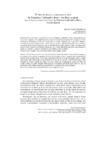El Arte de hacer y conservar el vino de Francisco Carbonell y Bravo: un falso original

Ver/Abrir
Use este enlace para citar
http://hdl.handle.net/2183/25098
Excepto si se señala otra cosa, la licencia del ítem se describe como Atribución-NoComercial-CompartirIgual 4.0 España
Colecciones
Metadatos
Mostrar el registro completo del ítemTítulo
El Arte de hacer y conservar el vino de Francisco Carbonell y Bravo: un falso originalTítulo(s) alternativo(s)
Arte de hacer y conservar el vino, by Francisco Carbonell y Bravo: A false originalAutor(es)
Fecha
2019Cita bibliográfica
Ibáñez Rodríguez, M. (2019). El Arte de hacer y conservar el vino de Francisco Carbonell y Bravo: un falso original. Revista de Lexicografía, 25, pp. 219-236. DOI: https://doi.org/10.17979/rlex.2019.25.0.6001
Resumen
[Resumen] El Arte de hacer y conservar el vino de Francisco Carbonell y Bravo, presentado por su autor como original, es en realidad una traducción. Se trata del primer tratado de enología en español publicado en Barcelona en 1820 por Antonio Brusi. Un hito importante de lo que fue la llegada a España de la ciencia enológica desde Francia. En este trabajo se fija la filiación del texto y el itinerario seguido desde la fuente francesa. Una vez identificado el original francés se hace un análisis comparativo entre la fuente y el tratado de Carbonell, con el fin de identificar qué partes son traducción y cuáles no y cuando lo es hemos valorado en qué medida y cómo se traduce. [Abstract] Arte de hacer y conservar el vino, by Francisco Carbonell y Bravo, introduced by its author as
an original work, is actually a translation. It is the first oenology treatise in Spanish and was published by
Antonio Brusi in Barcelona in 1820. It was a landmark in the arrival of the oenological science in Spain
from France. This work focuses on the filiation of the text and its journey from its French source. Once
identified the French original, an analysis has been carried out, comparing the source text with Carbonell’s
treatise, in order to identify which parts are a translation and which aren’t. Then we have assessed
how and to which extent the parts identified as a translation have been translated
Palabras clave
Tratado
Vino
Carbonell y Bravo
Falso original
Fuente
Treatise
Wine
False original
Source
Vino
Carbonell y Bravo
Falso original
Fuente
Treatise
Wine
False original
Source
Versión del editor
Derechos
Atribución-NoComercial-CompartirIgual 4.0 España
ISSN
1134-4539






